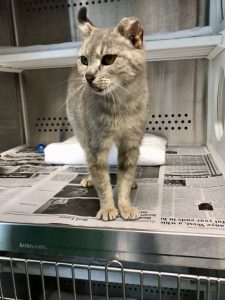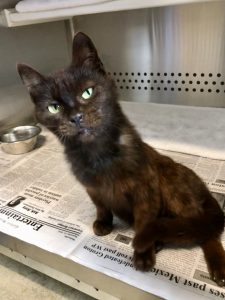Maddie’s® Shelter Medicine Program at Cornell provides 2-week Shelter Medicine clinical rotation opportunities to veterinary students. In this week’s Gimme Shelter Blog post, we will hear from Mary-Lee Barboza, a 4th year veterinary student currently completing her Shelter Medicine clinical rotation. #thankstomaddie #sheltermedicinesaveslives
“As a fourth year Cornell veterinary student on the Shelter Medicine clinical rotation, I have been enjoying many opportunities to learn about shelter management and decision making, animal behavior, environmental enrichment, and individual and population-level medicine for shelter animals.I have found it particularly rewarding to work with a number of cats who have come to the Tompkins County SPCA from a hoarding situation. Over the past week, shelter staff and veterinarians have been working with the Tompkins County Animal Control Officers for “staged intake” of these cats. This means that small groups of these cats are being brought in to the shelter at one time, so we make sure that we have enough enclosures to safely house the cats, as well as enough staff to appropriately care for the cats.When we first tried to examine and vaccinate them, most of the cats were purring and rubbing up against us so much that it was very difficult to examine them – a good problem to have! This was particularly amazing to me considering the unfortunate situation these cats just came from. Because there were so many cats, we came up with a naming theme, and decided to name all the cats after carnival rides, such as Scrambler, Condor, Ferris Wheel, Teacups, Carousel, Kamikaze, and Gravitron. They collectively became known as the “Carnival Cats.”Animals coming from a hoarding situation often have not had appropriate housing, nutrition, or care. They often live in unsanitary conditions with too many animals for the space. This often causes them to appear unkempt and predisposes them to illness, parasitism, and infection. Many of the “Carnival Cats” were severely underweight, were missing several teeth, had scruffy-looking or missing fur, had very dirty ears, and were showing signs of upper respiratory infection such as sneezing and discharge coming from their eyes and noses. Upper respiratory infections, or URI’s, are common in stressed cats housed in crowded unsanitary conditions and can be caused by viral infection, bacterial infection, or both. We prescribed eye drops and antibiotics to treat the Carnival Cats’ upper respiratory infections. Since many were missing fur and had dirty ears, each of the cats received a topical medication to treat fleas, ear mites, and intestinal parasites.I am glad that after only a few days in our care, and with only minor medical interventions, the Carnival Cats are beginning to look brighter and healthier! Many of them are learning to use a litter box, something they may not have done in their previous living situation. Some of the cats require dental work to remove fractured teeth, and one cat has a severely overgrown nail that needs to be removed. Once the cats are healthy, we will spay and neuter them so that they will be adoptable to homes where people can give them the care and attention they need!As a student interested in general practice and shelter medicine, I appreciated gaining hands-on experience recognizing and treating common medical conditions in shelter cats, while making a big difference in the Carnival Cats’ lives!”
Written by Mary-Lee Barboza (4th year vet student at Cornell University College of Veterinary Medicine)




